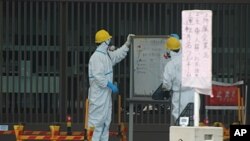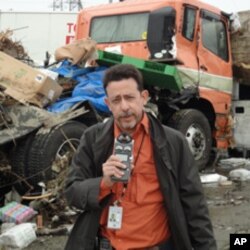VOA correspondent Steve Herman was the first of two American reporters to gain entry to the grounds of the crippled Fukushima Daiichi ('daiichi' means 'one' in Japanese) nuclear power plant on Wednesday. But the duo was permitted no farther than the main gate.
Since the March 11 magnitude 9.0 earthquake and subsequent tsunami destroyed part of the Fukushima Daiichi nuclear power plant here, few reporters seem to have attempted to reach the facility.
Correspondents are usually the first to race to any disaster site or combat zone, but fear of bodily harm by an invisible culprit seems to have restrained typical reportorial instincts.
There is, actually, no legal reason barring us despite a perception to the contrary.
Although police at lightly manned roadblocks try to prevent any unauthorized vehicles from entering the 20 kilometer radiation exclusion zone, as of March 13, they have no means to legally enforce the barricades.
That is expected to change at any moment, according to Japan's government, which earlier in the week designated five additional municipalities as part of the "deliberate evacuation area" and announced the entire zone will be legally off-limits, even to homeowners scurrying back in to retrieve belongings (as we discovered Tuesday in nearby Namie).
The enforcement will begin when the Prime Minister instructs mayor and village heads in the zone that he has established a binding ''caution area.'' After that only those who are engaged in disaster relief or who work at the Fukushima nuclear plant will be permitted to enter. Violators will face arrest and an as-yet-unannounced punishment.
Northeast Asia bureau chief John Glionna of the Los Angeles Times and I gained access all the way to the main gate of Fukushima Daiichi on Wednesday.
Police instructed us not to open our vehicle windows and to report to a radiation screening center in the town of Tamura afterwards, where we should wash the truck.
As we moved towards "ground zero" we passed kilometers of fields from which farmers have fled. For most of the 20-kilometer journey we spotted only police, military and other official vehicles. Even those we could count on one hand.
Not a single person was seen outside in Futaba and Okuma, which until March 11 had a combined population of about 18,500. The doors of some businesses remain open through which people hastily fled when the ground shook with unprecedented fury.
Some of the roads cannot be traversed in a normal car. The pavement in places was split apart by the quake. A railroad overpass lies crumpled next to one road. Power poles lean at sharp angles.
The immediate area around Fukushima Daiichi is relatively unscathed. The worst damage was over the other side of the hill when a tsunami, believed to have reached 14 meters in height (more than eight meters than the planned worst case scenario) washed away backup generators to cool the plant's reactors and fuel rods after power was cut by the earthquake. That set off an unimagined chain reaction of one disaster after another, which have been front page news around the world nearly every day for the past month.
After a drive up the slope to the main gate of Fukushima Daiichi we were greeted by two guards outfitted in hazmat suits, helmets and dual intake respirator masks.
Perhaps "greeted" is the wrong word.
|
Listen to Steve Herman describe Fukushima's nuclear power plant.
|
Our attempts to ask questions were rebuffed. The only return communication was the hand signal to make a U-turn. The license plate of our vehicle was noted. It was manifestly clear we could not proceed further and were not encouraged to loiter.
In the parking lot, I spotted a panel with one of those messages typically seen at industrial or construction sites. It was a billboard erected by the "TEPCO Fukushima 1 Nuclear Power Plant Safety Committee."
The message, obviously unchanged since March 11, makes what can only be read now as an extremely ironic proclamation: "This month's safety slogan: Be sure to check everything and do a risk assessment. Zero disasters for this year."
Steve Herman is VOA's Northeast Asia regional bureau chief, based in Seoul. He has been reporting on the natural and nuclear disasters from Japan for much of the past month.


















